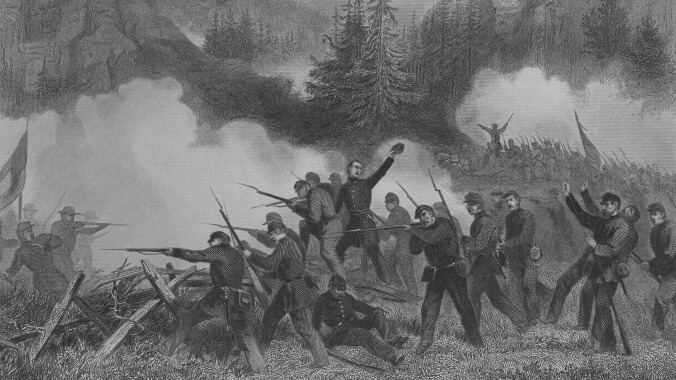Meet the trans man who fought in the Civil War

This week’s entry: Albert Cashier
What it’s about: One of the earliest recorded trans men in American history. Albert D.J. Cashier was assigned female at birth in County Louth, Ireland, in 1843 and emigrated to Illinois at a young age (exactly when isn’t clear). Cashier lived as a man from his teens until his death at age 71, and his story was remembered while others’ were forgotten because of his service in the Civil War.
Biggest controversy: Cashier’s male identity was affirmed by no less than the U.S. Army. At some point after emigrating, Cashier was given men’s clothing by an uncle or stepfather so he could find work in a shoe factory. He adopted the name “Albert Cashier” first to work, then to live on his own, and enlisted under that name when Lincoln called for soldiers to preserve the Union in 1862. Cashier survived the war and lived another 50 years, and only a few friends knew his gender was different from the one assigned to him at birth. A year and a half before his death, Cashier was experiencing dementia and moved to a state hospital. When the staff there undressed him, they forced him to wear women’s clothes. The veterans’ pension board was notified, and a fraud investigation began. But soldiers who served with Cashier affirmed that he was the same man they served alongside, and the Army decided to recognize the elderly veteran as Albert Cashier and continue pension payments for life.
Strangest fact: Wikipedia stops short of calling Cashier transgender. Despite living as Albert for 53 years, the article consistently uses language like, “some contemporary scholars… suggest Cashier was a trans man,” or “authors… have suggested or argued…” It does seem consistent with Wikipedia’s style to not state something definitively when there isn’t a clear historical record, but Cashier lived as a man for 53 of his 71 years, so it seems like about as clear-cut a case as you’ll find.
Thing we were happiest to learn: Cashier had quite a career as a soldier. He fought in 40 battles, serving under Grant in the Army of the Tennessee. He survived the Battle of Brice’s Crossroads—a debacle for the Union that resulted in heavy casualties—as well as the Franklin-Nashville Campaign, the defense of Nashville, and the battles of Spring Hill and Franklin. He was captured once while on reconnaissance, but quickly escaped. Cashier traveled about 9,000 miles in total before being honorably discharged at war’s end.
Thing we were unhappiest to learn: Life wasn’t always easy for a Civil War vet. Cashier returned to Illinois, doing odd jobs around town, and working for the Chesbro family in exchange for room and board. Eventually the Chesbros built Cashier a small house, where he lived for 40 years, continuing to work odd jobs. In 1911, 67-year-old Cashier was hit by a car that broke his leg. He was unable to work, and moved to a nearby soldiers and sailors home, where he was visited by war buddies. After three years, dementia set in to the point where he was moved to Watertown State Hospital For The Insane, where the aforementioned fraud investigation began.
Best link to elsewhere on Wikipedia: More than 250 Civil War soldiers were assigned female at birth, although most are assumed to have been cisgender women in disguise for the purpose of skirting Army regulations. Some fought to stay close to a husband or lover, some enlisted to escape slavery, and some simply wanted to serve either their country, or the rebellion against it. One woman, Malinda Blalock, even did both, fighting for the Confederates in her native North Carolina, and then crossing enemy lines and joining the Union army when her commanding officer, George Washington Kirk, switched sides.
Further down the Wormhole: Wikipedia naturally has more information on trans men, as well as a list of LGBT-related films, but we’ll look at the small screen as we continue Pride month with Wikipedia’s list of TV series with bisexual characters next week.